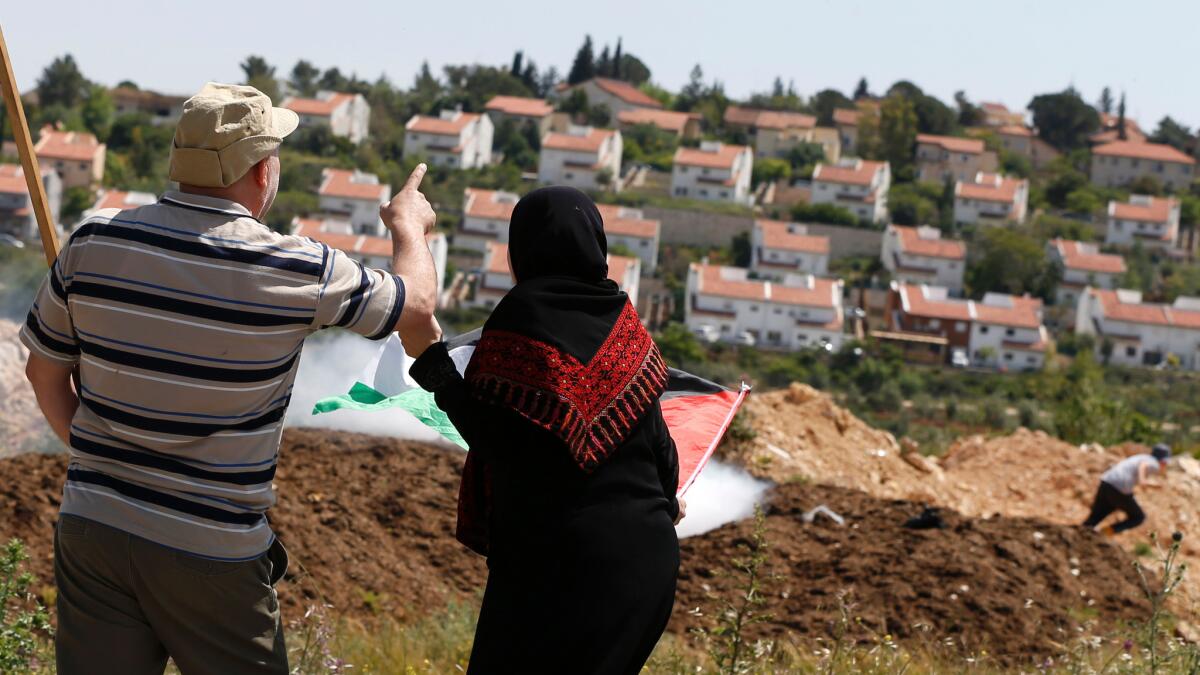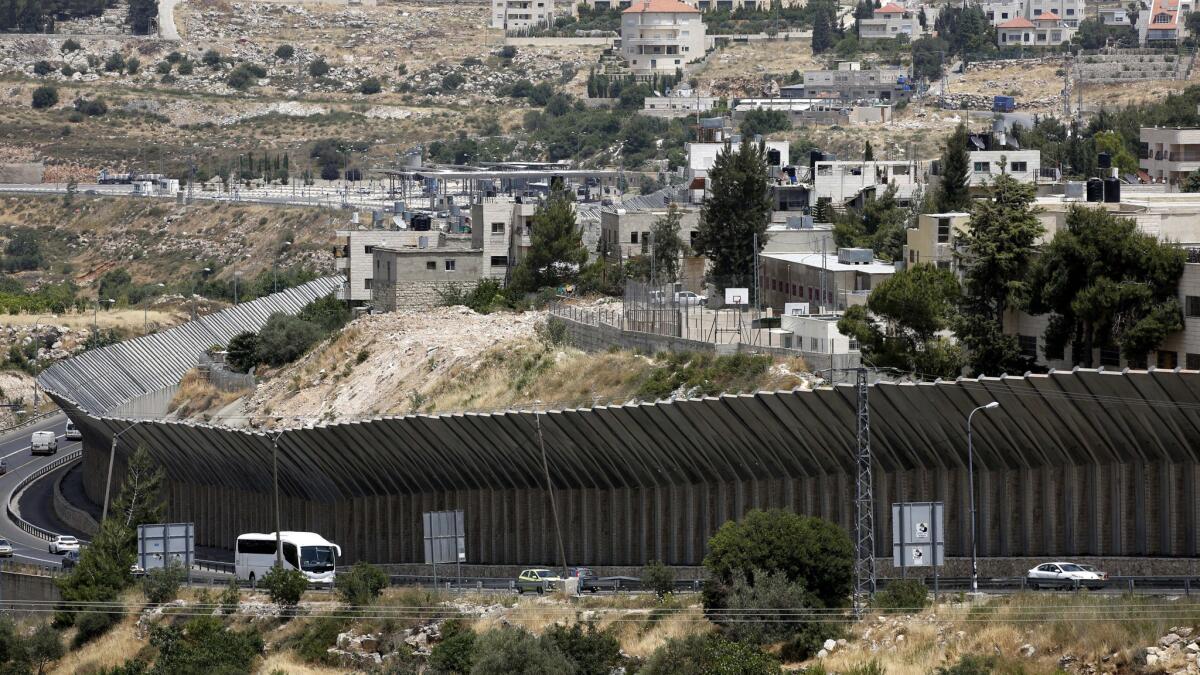‘The Way to the Spring’ is a sobering look at Palestinian life and resistance in the West Bank

- Share via
The way to the spring…is blocked. At least that’s the case for the Palestinians of Nabi Saleh, a small village northwest of Ramallah. The expansion-minded residents of a nearby Jewish settlement, with the aid of the Israeli army that occupies the West Bank, have taken over the town’s water source, which Palestinian farmers depended on to irrigate their fields.
Ben Ehrenreich, an award-winning writer based in Los Angeles, discovered as much when he moved to the West Bank, which Israel captured from Jordan in a war with its Arab neighbors in 1967. Ehrenreich, who lived in that troubled land intermittently between 2011 and 2014 (in part, reporting for Harper’s and the New York Times Magazine), demonstrates that Nabi Saleh is no anomaly. “The Way to the Spring: Life and Death in Palestine” emerges as a sobering, iconoclastic “collection of stories about resistance, and about people who resist,” marred slightly by the author’s unwillingness to subject Palestinian militant activity, which has often included terrorism, to moral scrutiny.
“The spring is the face of the occupation,” Bassem Tamimi of Nabi Saleh tells the author. Every Friday, the villagers, joined by international and Israeli solidarity activists, march toward it in a regularized act of protest. “And every Friday Israeli soldiers beat them back with tear gas, stun grenades, and rubber-coated bullets,” observes the author. Afterward, groups of male youths situated some distance away hurl stones at the soldiers, who are generally beyond their reach.
Whether Ehrenreich accompanies Tamimi, an advocate of unarmed resistance who has come to the attention of the international media, or others – additional members of Nabi Saleh’s Tamimi clan, the beleaguered residents of what he memorably terms “Planet Hebron” or Palestinians in other areas – he witnesses the disturbing institutionalized discrimination and “casual violence” of an occupation now nearly half a century old. Those eager to dismiss Ehrenreich’s shocking anecdotes as selective would do well to take heed of the facts and figures that the author, like others before him, painstakingly cites to support his arguments.
He explains that while Israel blockades (and sometimes bombs) one Palestinian territory, the Gaza Strip, it occupies the other, the West Bank, and employs two separate legal systems to govern its inhabitants. Israeli Jews who, in violation of international law, expropriate Palestinian land and build settlements in which Palestinians are (with rare exceptions) denied the right to reside, remain under the jurisdiction of Israeli civil courts, but Palestinians (excluding those of East Jerusalem) are subject to military rule. Acts of resistance real or imagined, peaceful or violent, directed at this state of affairs are almost inevitably punished. Ehrenreich notes that “in 2010, the last year for which records were made public, 99.74 percent of Palestinians tried in the military court system were convicted.” While languishing in that system, one might experience the highly euphemistic “moderate physical pressure” that Israeli law authorizes the Shin Bet (Shabak) security agency to mete out.
With time, the Jewish settlements have grown. (The roads connecting them to each other and to Israel proper – from which Palestinians are barred – have also multiplied.) As Ehrenreich notes, West Bank settlers now number more than 350,000, having “tripled since the beginning of the peace process in 1993.” (If one includes Israeli Jews who have moved into pre-existing and newly created neighborhoods in Occupied East Jerusalem, as Israeli watchdog B’Tselem does, the figure rises to more than half a million.) To make matters worse, Israel controls the water supply in the West Bank, diverting more of it to the settlers than the far more numerous Palestinian population. And all the while, the Jewish state refuses to grant building permits to Palestinians who live in or want to move to Area C, which takes up a whopping 61% of the West Bank and is directly under Israeli administration (meaning that the Palestinian Authority is clearly misnamed – it exercises no authority there).
There are a few problems with “The Way to the Spring.” All the resistance Ehrenreich documents in Nabi Saleh, Hebron and elsewhere is either nonviolent or potentially violent but in reality ineffectual (as with the youths throwing stones at heavily armed and armored soldiers). He acknowledges that Palestinians have resorted to violence and sometimes killed Israeli civilians, but he doesn’t linger on this issue or reveal his thoughts on the matter, despite the generally reflective nature of his writing. Where does Ehrenreich draw the line between armed resistance and terrorism?
Also, Ehrenreich seemingly adopts the reductive position that only Palestinians who resist the occupation deserve respect and sympathy. Toward Palestinians who shun resistance, either because they consider it futile or want to avoid arguably noble but perennially dangerous pursuits, he has nothing but scorn. This accounts for his fulminations against Rawabi, a pre-planned Palestinian city in the West Bank. There is much to criticize: The Palestinian Authority, which spearheaded the project, is corrupt and oppressive, the city caters to the middle and upper classes, and Israeli contracting firms benefit from its construction. Still, his description of Rawabi as “an extrusion in stone and glass . . . inhabitable scat deposited by capital on its way to a goal that excluded nearly everyone” is overly indignant and comically fustian.
These concerns aside, Ehrenreich deserves kudos for digging beneath the unsightly outer manifestations of the occupation to reveal its even uglier innards.

Consider the notorious separation barrier. Israel’s stated reason for building the wall, up to eight feet high in places, was to prevent West Bank Palestinians from carrying out terror attacks – including suicide bombings – within Israel during the Second Intifada (2000-05). That was conceptually sound. Yet instead of building it along the Green Line, the territory’s boundary, Israel constructed the barrier within the West Bank, strengthening its grip on the larger Jewish settlement blocs (which now lie on the Israeli side of the wall) and confiscating more Palestinian land, dividing villages in the process.
That wall is only a recent example of Israel’s continuous efforts to cement its control over the territory in question. “[W]hen the Israelis occupied the West Bank in 1967,” Ehrenreich writes, “they began to selectively apply certain Jordanian laws based in the Ottoman Land Code of 1858, which ruled that any acreage left uncultivated for three consecutive years…would revert to the state, which could transfer the land to private owners. Meaning settlers.” For decades, Israel has utilized such mechanisms to expand Jewish settlements while limiting Palestinian building density to specific areas.
And so it goes. As a result, the generally bleak outlook pervading “The Way to the Spring” must count as its finest feature. This will strike some readers as counter-intuitive; after all, a book on the Israeli-Palestinian conflict is supposed to show us how tantalizingly close we are to resolving it, no? Yet the principled and blunt Ehrenreich won’t oblige. The only thing he’s optimistic about is continued Palestinian resistance, of the sort the villagers of Nabi Saleh and elsewhere undertake.
Otherwise, the way he assesses the import of Israeli Prime Minister Benjamin Netanyahu’s statement in 2014 that “there cannot be a situation, under any agreement, in which we relinquish security control of the territory west of the River Jordan” captures the thrust of this book, and the mood among many Palestinians. All of the West Bank, of course, lies west of the Jordan River. “In other words,” Ehrenreich writes, “the Palestinians would get no state. Ever. The occupation would not end.”
Al-Shawaf is a writer and book critic in Beirut.
::
“The Way to the Spring: Life and Death in Palestine”
Ben Ehrenreich
Penguin Press: 448 pp., $28
More to Read
Sign up for our Book Club newsletter
Get the latest news, events and more from the Los Angeles Times Book Club, and help us get L.A. reading and talking.
You may occasionally receive promotional content from the Los Angeles Times.










